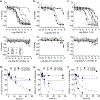Serum-Stable and Selective Backbone-N-Methylated Cyclic Peptides That Inhibit Prokaryotic Glycolytic Mutases
- PMID: 35904259
- PMCID: PMC9900472
- DOI: 10.1021/acschembio.2c00403
Serum-Stable and Selective Backbone-N-Methylated Cyclic Peptides That Inhibit Prokaryotic Glycolytic Mutases
Abstract
N-Methylated amino acids (N-MeAAs) are privileged residues of naturally occurring peptides critical to bioactivity. However, de novo discovery from ribosome display is limited by poor incorporation of N-methylated amino acids into the nascent peptide chain attributed to a poor EF-Tu affinity for the N-methyl-aminoacyl-tRNA. By reconfiguring the tRNA's T-stem region to compensate and tune the EF-Tu affinity, we conducted Random nonstandard Peptides Integrated Discovery (RaPID) display of a macrocyclic peptide (MCP) library containing six different N-MeAAs. We have here devised a "pool-and-split" enrichment strategy using the RaPID display and identified N-methylated MCPs against three species of prokaryotic metal-ion-dependent phosphoglycerate mutases. The enriched MCPs reached 57% N-methylation with up to three consecutively incorporated N-MeAAs, rivaling natural products. Potent nanomolar inhibitors ranging in ortholog selectivity, strongly mediated by N-methylation, were identified. Co-crystal structures reveal an architecturally related Ce-2 Ipglycermide active-site metal-ion-coordinating Cys lariat MCP, functionally dependent on two cis N-MeAAs with broadened iPGM species selectivity over the original nematode-selective MCPs. Furthermore, the isolation of a novel metal-ion-independent Staphylococcus aureus iPGM inhibitor utilizing a phosphoglycerate mimetic mechanism illustrates the diversity of possible chemotypes encoded by the N-MeAA MCP library.
Figures





Similar articles
-
Uniform affinity-tuning of N-methyl-aminoacyl-tRNAs to EF-Tu enhances their multiple incorporation.Nucleic Acids Res. 2021 Nov 8;49(19):10807-10817. doi: 10.1093/nar/gkab288. Nucleic Acids Res. 2021. PMID: 33997906 Free PMC article.
-
The RaPID Platform for the Discovery of Pseudo-Natural Macrocyclic Peptides.Acc Chem Res. 2021 Sep 21;54(18):3604-3617. doi: 10.1021/acs.accounts.1c00391. Epub 2021 Sep 10. Acc Chem Res. 2021. PMID: 34505781
-
Structure-activity relationship of ipglycermide binding to phosphoglycerate mutases.J Biol Chem. 2021 Jan-Jun;296:100628. doi: 10.1016/j.jbc.2021.100628. Epub 2021 Apr 1. J Biol Chem. 2021. PMID: 33812994 Free PMC article.
-
Engineering Translation Components Improve Incorporation of Exotic Amino Acids.Int J Mol Sci. 2019 Jan 26;20(3):522. doi: 10.3390/ijms20030522. Int J Mol Sci. 2019. PMID: 30691159 Free PMC article. Review.
-
Discovery of Functional Macrocyclic Peptides by Means of the RaPID System.Methods Mol Biol. 2019;2001:299-315. doi: 10.1007/978-1-4939-9504-2_14. Methods Mol Biol. 2019. PMID: 31134577 Review.
Cited by
-
Reprogramming the genetic code with flexizymes.Nat Rev Chem. 2024 Dec;8(12):879-892. doi: 10.1038/s41570-024-00656-5. Epub 2024 Oct 21. Nat Rev Chem. 2024. PMID: 39433956 Review.
-
Nα -Methylation of arginine: Implications for cell-penetrating peptides.J Pept Sci. 2023 May;29(5):e3468. doi: 10.1002/psc.3468. Epub 2023 Jan 4. J Pept Sci. 2023. PMID: 36494904 Free PMC article.
-
Cyclic β2,3-amino acids improve the serum stability of macrocyclic peptide inhibitors targeting the SARS-CoV-2 main protease.Bull Chem Soc Jpn. 2024 Mar 6;97(5):uoae018. doi: 10.1093/bulcsj/uoae018. eCollection 2024 May. Bull Chem Soc Jpn. 2024. PMID: 38828441 Free PMC article.
-
Promoting ribosomal incorporation of backbone-modifying nonproteinogenic amino acids into nascent peptides by ATP-binding cassette family-F proteins and EF-P.Nucleic Acids Res. 2025 May 22;53(10):gkaf446. doi: 10.1093/nar/gkaf446. Nucleic Acids Res. 2025. PMID: 40401556 Free PMC article.
-
Synthesis and in vitro Metabolic Stability of Sterically Shielded Antimycobacterial Phenylalanine Amides.ChemMedChem. 2024 Mar 15;19(6):e202300593. doi: 10.1002/cmdc.202300593. Epub 2024 Feb 29. ChemMedChem. 2024. PMID: 38329388 Free PMC article.
References
-
- Bockus AT; Schwochert JA; Pye CR; Townsend CE; Sok V; Bednarek MA; Lokey RS, Going Out on a Limb: Delineating The Effects of beta-Branching, N-Methylation, and Side Chain Size on the Passive Permeability, Solubility, and Flexibility of Sanguinamide A Analogues. J Med Chem 2015, 58 (18), 7409–18. - PubMed
-
- Chikhale EG; Ng KY; Burton PS; Borchardt RT, Hydrogen-Bonding Potential as a Determinant of the in-Vitro and in-Situ Blood-Brain-Barrier Permeability of Peptides. Pharmaceut Res 1994, 11 (3), 412–419. - PubMed
-
- Conradi RA; Hilgers AR; Ho NF; Burton PS, The influence of peptide structure on transport across Caco-2 cells. Pharm Res 1991, 8 (12), 1453–60. - PubMed
-
- Haviv F; Fitzpatrick TD; Swenson RE; Nichols CJ; Mort NA; Bush EN; Diaz G; Bammert G; Nguyen A; Rhutasel NS, et al., Effect of N-methyl substitution of the peptide bonds in luteinizing hormone-releasing hormone agonists. J Med Chem 1993, 36 (3), 363–9. - PubMed
Publication types
MeSH terms
Substances
Grants and funding
LinkOut - more resources
Full Text Sources
Research Materials
Miscellaneous

